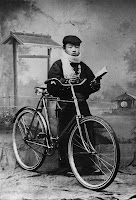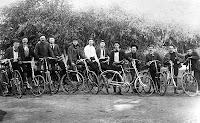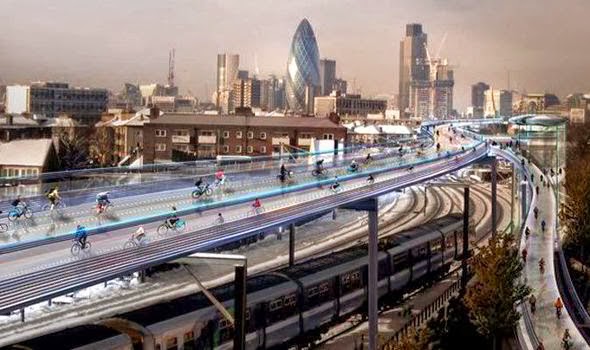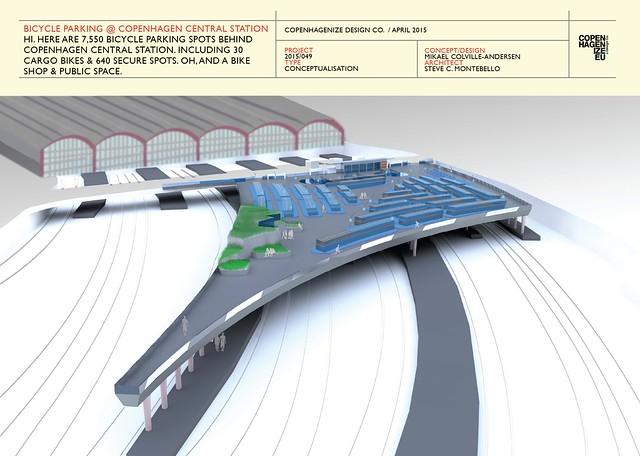Bicycle Urbanism by Design: Bicycle Infrastructure Fail(s)
Read More


Los Angeles. 1900. Spring St. near 8th.
The latest installment is from a city that enjoyed a modal share for bicycles of 20% at the turn of the last century and built impressive protected bicycle infrastructure like this 10 km, elevated cycle track back in 1900.
Alas, the bicycle disappeared from this area that was described like this in an 1897 newspaper article: "There is no part of the world where cycling is in greater favor than in Southern California, and nowhere on the American continent are conditions so favorable the year round for wheeling."
Thanks to our reader, Rick, we found these photographs showing the bicycle as an accepted and respected part of life in Los Angeles in the Los Angeles Public Library archives.
We all know what happened when the car industry went after another competitive transport form.













Where cities put their bicycles. Above ground. On street level. Woven into the urban fabric. Well… not ALL cities. I meet amazing, inspiring people when I travel the world with my work. I see a lot of things. Many of the things are good. Many are, however, strange and frustrating. Especially regarding infrastructure. It boggles my mind every time I - or worse, ride on - bike lanes on the wrong side of parked cars in between the door zone of primarily single-occupant vehicles and moving traffic in North American cities and I thumb my nose at every sharrow I see. That fakest of all fake bicycle infrastructure. That sheep in wolf’s clothing. Despite a century of Best Practice in bicycle infrastructure and tried and tested networks occupied by tens of thousands of daily cyclists in cities that “get it”, there are still so many mistakes being made elsewhere. I see stuff slapped lazily into place by engineers and planners who don’t ride bicycles in their city and who haven’t even tried it. Mutant Frankeninfrastructure from the lab of a Marvel Comics nemesis’ laboratory.
The streets of our cities were, for 7000 years since cities first were formed, the most democratic spaces in the history of homo sapiens. When the automobile appeared, the world's longest reigning urban dictatorship took over. Rest assured, there are signs of a Velvet Revolution (I tried to work velo into that... velovet... velo-vet... nevermind) forming. Passionate advocates for life-sized cities are meeting in earnest in the back rooms of coffee houses down the back streets. Recruiting more and more planners and even engineers - even though some of the latter group get strongarmed. Certain prominent figures are heard saying extraordinary things. Like the Mayor of Paris until last year, Bertrand Delanoë, who said, "The fact is that cars no longer have a place in the big cities of our time". He backed up his vision with action. Transforming Paris into something more beautiful in his 12 years at the helm. Not just bikes and infrastructure but traffic calming and lowering speed limits, among many other things.
Nevertheless, the motordom regime continues its rule. Erich Honecker has yet to be kissed. The transport wall remains for now.
Where there is hope, there is wackiness to make you roll your eyes, weep, utter expletives. Often all at once. There is one in every crowd, they say. The kid in the class who isn't paying attention and disrupts everyone else with unruly behaviour and lame jokes that fall flat and do little to garner respect.

£220 million for a few miles? Like Marie Kåstrup from the City of Copenhagen said, even if Copenhagen had that kind of money they wouldn't build a Skycycle. It would take cyclists off the streets and remove them from the urban fabric and places they need to go. I've written about The Ridiculous Skycycle by Norman Foster before. I'll let you read that. Onward.

I'll let CityLab tackle this one. They might be more diplomatic about it.

Sorry to break this to you, but there is a companion film to this "concept".
Read more about it at The Guardian. They're a bit nicer about it.
Sure, there are tunnels for cyclists. Tunnels that serve a specific function on an A to B journey. Like in San Sebastian. Like the tunnel under the river in Rotterdam, built in the 1930s. Much has been learned since then. The Dutch do an amazing job at underpasses and they keep them light and airy. The Danes pipe pleasant music into dark bike parking facilities to keep people comfortable - and generally avoid tunnels altogether, with only a few underpasses around. Keeping cyclists above ground is a design standard here.
Some people have likened the Bicycle Snake / Cykelslangen in Copenhagen to Norm's Skycycle. No. The Bicycle Snake is a BRIDGE. Solving a problem at one specific location. Not putting cyclists out of sight, out of mind. Apples and oranges. Arsenal and Tottenham.
If you look at innovation - real innovation - regarding bicycle infrastructure, you'll notice that it always prioritizes cyclists and serves a practical, logical function. The Bicycle Snake is a great example. The Floating Roundabout in Eindhoven? Same thing. The Green Wave for cyclists, rain sensors for cyclists, Or any of these things mentioned here.
You'll also notice that they are simple in nature. Simple, rational and functional. Based on an understanding of how bicycles in cities used to work, still work and can work.We have everything we need. We know everything we need to know. What to shift people over to other modern, intelligent transport forms? This is all you need.
Innovation in cities is simple. Use 7000 years of experience. It's right there. It's free. It works. Truly smart cities don't overcomplicate.
Samuel Johnson famously quipped that, "...when a man is tired of London, he is tired of life." That was 1777. Nowadays, regarding urban innovation, when a person is tired of London, they give it one star on TripAdvisor, a scathing review and they hop on the Eurostar to Paris or fly to Berlin or Barcelona or Copenhagen or Amsterdam or... etc.

 For all of Copenhagen’s badassness as a bicycle city, there remains one thing that the City still completely sucks at. Bicycle parking at train stations. At Copenhagen Central Station there are only about 1000 bike parking spots. Danish State Railways can’t even tell us how many spots they have. They’re not sure.
For all of Copenhagen’s badassness as a bicycle city, there remains one thing that the City still completely sucks at. Bicycle parking at train stations. At Copenhagen Central Station there are only about 1000 bike parking spots. Danish State Railways can’t even tell us how many spots they have. They’re not sure.
Even in Basel they have 800+. In Antwerp they have this. Don't even get me started on the Dutch. 12,500 bike parking spots are on the way in some place called Utrecht. Amsterdam has a multi-story bike parking facility, floating bicycle barges round the back and are planning 7000 more spots underwater.
Even at the nation's busiest train station, Nørreport, the recent and fancy redesign failed miserably in providing parking that is adequate for the demand. Architects once again failing to respond to actual urban needs.
It is time to remedy that. Here is my design for 7550 bike parking spots behind Copenhagen Central Station. Steve C. Montebello is the architect that I worked closely with. By exploiting the area over the train tracks and using Tietgens Bridge as the transport spine, we have created an iconic bicycle parking facility with ample parking spots at this important transport hub where trains, buses and - in 2019 - the Metro converge in an inter-modal transport orgy.In our work on the EU project BiTiBi.eu - Bike Train Bike - we have been focused on parking solutions at train stations. It was a natural evolution to use that experience in developing this project.
 The structure is supported by columns and utilises the existing platforms below, which dictated the shape that we decided upon. There are: - 6880 bike parking spots in double-decker racks. This can be expanded with 1360 more if necessary. - 30 dedicated cargo bike parking spots featuring. - 640 secure, indoor bike parking spots in the green roofed building at left (above). - A bike shop for repairs and maintenence. - Ticket machines and displays for departures and arrivals of trains and buses. - At the end of the long point, the belvedere will be the world's premiere, dedicated lookout spot design for trainspotters.
Here is the view of the area as it is today.
There are four on/off ramps from Tietgens Bridge for ease-of-access.
A secure bicycle parking facility will house 640 bikes.
The structure is supported by columns and utilises the existing platforms below, which dictated the shape that we decided upon. There are: - 6880 bike parking spots in double-decker racks. This can be expanded with 1360 more if necessary. - 30 dedicated cargo bike parking spots featuring. - 640 secure, indoor bike parking spots in the green roofed building at left (above). - A bike shop for repairs and maintenence. - Ticket machines and displays for departures and arrivals of trains and buses. - At the end of the long point, the belvedere will be the world's premiere, dedicated lookout spot design for trainspotters.
Here is the view of the area as it is today.
There are four on/off ramps from Tietgens Bridge for ease-of-access.
A secure bicycle parking facility will house 640 bikes.
 There will be a space for a bike shop for repairs and maintenence located at the entrance, next to ticket machines and displays featuring departures and arrivals for trains and buses.
The parking with have signs with areas divided up alphabetically, so you can find your bike again.
There is access to the three platforms below by stairs that will, of course, have bike ramps. Duh.
There will be a space for a bike shop for repairs and maintenence located at the entrance, next to ticket machines and displays featuring departures and arrivals for trains and buses.
The parking with have signs with areas divided up alphabetically, so you can find your bike again.
There is access to the three platforms below by stairs that will, of course, have bike ramps. Duh.
This facility will right so many wrongs and will thrust Copenhagen into the 21st century regarding bicycle parking at train stations. If we are to maintain the momentum of a blossoming bicycle-friendly city, we need to up our game regarding parking.


The Metro is already falsely advertising the travel times. Advertising station to station, but not the first and last mile to and from the station. We did our own travel time survey using real world scenarios and the bike usually beats the Metro in Copenhagen.
Fine. We don't like the Metro but damn, right now, we love the Metro construction. The City is following the traffic planning guide for liveable cities to the letter. Copenhagen has 17 Metro stations under construction and this is having a massive effect on mobility patterns in the city. Driving is a pain in the ass. What has happened?Cycling levels have stagnated for years in Copenhagen. Hovering between 35% and 38%. Falling from 37% to 35% after intense helmet promotion.
Now there are new numbers from the Danish Technical University's Travel Survey. Between 2012 and 2013, the modal share for bicycles (people arriving at work or education in the City of Copenhagen) exploded from 36% to 45%. Forty-five percent. A leap of 9%. That has never happened anywhere. Ever. Seriously. The car's modal share fell from 27% to 23%. But wait, there's more. The average trip length in Copenhagen rose 35% from 3.2 km to 4.2 km between 2012 and 2013. That means that the oft-quoted statistic about how Copenhageners cycle 1.2 million km a day need to be upgraded to 2,006,313 km per day. Since 1990, by the way, the number of cyclists has risen 70% in Copenhagen. The number of car trips into the city centre has fallen from 350,000 to 260,000.
Between 2012 and 2013, the modal share for bicycles (people arriving at work or education in the City of Copenhagen) exploded from 36% to 45%. Forty-five percent. A leap of 9%. That has never happened anywhere. Ever. Seriously. The car's modal share fell from 27% to 23%. But wait, there's more. The average trip length in Copenhagen rose 35% from 3.2 km to 4.2 km between 2012 and 2013. That means that the oft-quoted statistic about how Copenhageners cycle 1.2 million km a day need to be upgraded to 2,006,313 km per day. Since 1990, by the way, the number of cyclists has risen 70% in Copenhagen. The number of car trips into the city centre has fallen from 350,000 to 260,000.  The 45% number includes people arriving in Copenhagen from surrounding municipalities (there are 22). Among citizens of the City of Copenhagen itself, a whopping 63% use a bike to get to work or education and only 10% drive a car. Another rise in cycling and a drop in car use.
The 45% number includes people arriving in Copenhagen from surrounding municipalities (there are 22). Among citizens of the City of Copenhagen itself, a whopping 63% use a bike to get to work or education and only 10% drive a car. Another rise in cycling and a drop in car use.
Okay, okay. But what does it all MEAN? When the results of the travel survey came out, journalists were scrambling for answers. Two researchers at DTU were "surprised". They were quoted in the Danish press as saying things like, "uh... the City's new bridges and traffic calming on certain streets seem to have worked. Giving cyclists carrots encourage cycling."
The detail they forgot was that the new cycling bridges aren't finished yet, nor is the traffic calming on Amagerbrogade. The Nørrebrogade stretch is from 2008. Cycling rose on that street by 15% but that was BEFORE 2012. Duh. Bascially, there hasn't been much carrot dangling in this city for a few years. So forget about THAT hastily thunk up theory. Things are happening NOW, in 2013 and 2014, sure, but that has nothing to do with the data from 2012 to 2013. Double Duh. What HAS happened is that 17 huge construction sites fell out of the sky all at once. Not something that happens every day. In addition, most of central Copenhagen - between 2012 and 2013 - was under further construction because of the upgrading of district heating pipes under many streets that had to be ripped up. Look at the guide at the top again. THAT is what has happened. Driving was rendered incredibly difficult. Copenhageners, being rational homo sapiens, chose other transport forms. Public transport has increased, too, but the bicycle is clearly the chariot of choice. It's no surprise at all why cycling is booming. What is happening right now is a fantastic urban experiement. So much data and experience is and will become available. Mark my words, however. When the Metro construction is finished in 2018... probably 2019... we will see a sharp drop in cycling levels, back to the standard levels we plateaued with for the past few years. You read it here first.Unless, of course, the City of Copenhagen has the cajones to embrace this experiment and use it to finally make The Leap - as described by author Chris Turner - into the future of our city. Expanding and widening the cycle tracks. Reallocating space from falling car traffic to bicycles and public transport. The new BRT route in Copenhagen is a good step. Let's see how much farther we can go. Designing cities instead of engineering them. The citizens have shown us that they will be on our side if we do the right thing.
Otherwise, this rich petri dish experiment will just rot and be forgotten.

 Continuing in our series of Desire Line Analyses, we decided to cast our critical and curious eyes on yet another Copenhagen intersection, this time where Bremerholm meets Holmens Kanal. We decided to be more specific and focus on one part of the intersection - a location that we know well and one with a specific congestion problem in rush hour. We filmed for one hour from 08:15-09:15.
Continuing in our series of Desire Line Analyses, we decided to cast our critical and curious eyes on yet another Copenhagen intersection, this time where Bremerholm meets Holmens Kanal. We decided to be more specific and focus on one part of the intersection - a location that we know well and one with a specific congestion problem in rush hour. We filmed for one hour from 08:15-09:15.
Behaviour vs Design
With the massive numbers of bicycle users in the mornings in Copenhagen, bottlenecks occur at a number of locations, particularly where many bicycle users need to turn left. This is something that all of us at the company experience each morning so we decided to study it.
It was a November morning and it was party-cloudly, dry and 6 degrees C. The focus was to determine how bicycle users react to the sub-standard design of this location. How they react to having to battle with motorised traffic - something that is unusual in the city. Yep, even in Copenhagen, The Arrogance of Space is present at times.
With this study we look at how bicycle users react to the design of infrastructure at one specific location, their behaviour and adherance to traffic laws and how they interact with other traffic users, in particular cars. All in one tight, congested location. As always, we apply Direct Observation and Revealed Preferences, as opposed to Declared Preferences in order to explore how to improve conditions for bicycle users in the interest of improving flow, capacity and safety.
For more Desire Line Analyses, see: copenhagenize.eu/projects.html#desire
.png)
Here is the map of the intersection in question.
You can check out the full report here.
This short analysis revealed quite a lot of interesting revelations in the behaviour of the bicycle users. We have established that Copenhagen has the world’s best behaved bicycle users. We wondered if that track record would stand the test at an intersection that is far below the Copenhagen par in its design.
71% of all traffic in the observation period were bicycle users.
86% of all left-turning bicycle users observed performed the textbook Copenhagen Left. The majority of those who didn’t were reacting to the congestion.
1:3 - For every vehicle there were three bicycle users. Imagine if they were all in cars. This might jog your memory.
1560 - This Desire Line analysis mapped the Desire Lines of 1560 cyclists on their way to work or education during morning rush hour at the Bremerholm - Holmens Kanal intersection.
Bremerholm - Holmens Kanal intersection: 1560 Cyclists (from 8:15am to 9:15)

During the morning rush hour, the intersection is characterised by congestion at the corner with bicycle users waiting for the green light. The traffic law dictates that the Copenhagen Left - or the box turn - is required. Bicycle users are not, however, required to wait for the light to turn green. They can cross if there is no traffic. Two main behavioural patterns were observed. The first where bicycle users are turning left in great numbers and also how bicycle users coming down Bremerholm interact with motor vehicles upon reaching the light. These two scenarios interacted with each other, and should not be considered to be mutually exclusive events.
Detailed Observations of cyclists waiting at Bremerholm
Here we see how bicycles and vehicles interact inside the same space. At this location, the bike lane ends before the intersection and bicycle users share the space with right-turning cars. This design was standard for a few years, but now pulling back the stop line for cars at intersections is the new design approach. The general rule of thumb is that whoever gets to the intersection first - be it a car or a bicycle user - can decide to hug the curb. Cars invariably hugged the curb, leaving - at this location - no space for bikes. Because of their expectations due to the uniformity of design elsewhere in the city, bicycle users invariably found a way of getting ahead of the cars at the red light.
Detailed Observations of cyclists waiting at Bremerholm doing the Copenhagen Left

It was interesting to observe how bicycle users waited at the light when turning left. It had little to do with the volume of bicycles but rather the behaviour of those who arrive first on the scene. The following bicycle users invariably followed their lead, either lining up across the intersection or bunching up behind them.
Further Data
Further data and observations were gathered from this Desire Line analysis.The data of each of the different forms of traffic was then broken down (shown below).

The observations of the cyclists.

Vehicular data was broken down.

Along with pedestrian data.

It was interesting to note the flow of traffic per traffic light turn and compare the flow of bicycles to cars. While the flow of vehicles remains rather constant at 9 cars per green light over the morning rush hour, the flow of bicycles varies greatly. This demonstrates that bicycles can get through an intersection quicker than vehicles do.

Copenhagenize Fixes Finally we offer our recommendations for redesigning the intersection. When the vast majority of the users are on bicycles, democracy would indicate that there are easy redesigns available to prioritize them.

Read the full pdf from the Copenhagenize Design Company website.
